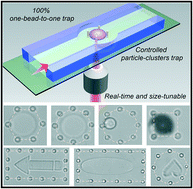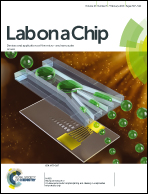Real-time two-photon lithography in controlled flow to create a single-microparticle array and particle-cluster array for optofluidic imaging†
Abstract
Microarray technology provides an excellent platform for biomedical and biochemical research including basic scientific studies, drug discovery, and diagnostics. Here, we develop a novel method referred to as real-time two-photon lithography in a controlled flow in which femtosecond laser two-photon lithography is performed in situ in the sequential mode stopping and flowing the flow of liquid resin containing microparticles to achieve 100% trapping on a one-bead-to-one-trap basis. Polydisperse particles can be all trapped to form a desired array by freely designing trap structures, resulting in an unprecedentedly high capture efficiency of ∼100%. No persistent pressure is needed after trapping which reduces the complexity of the system. In addition, trapping of particle-cluster arrays with a controlled number of particles is also achieved via this method. The trapped particles inside the microchip are successfully applied as microlenses for high quality imaging. The present technology marks an essential step towards a versatile platform for the integration of bead-based assays and paves the way for developing innovative microfluidics, optofluidics, micro-optics and single-cell analysis devices.



 Please wait while we load your content...
Please wait while we load your content...